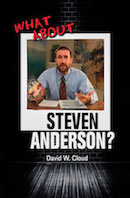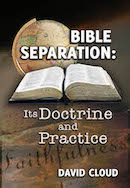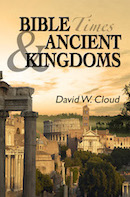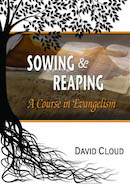866-295-4143, fbns@wayoflife.org
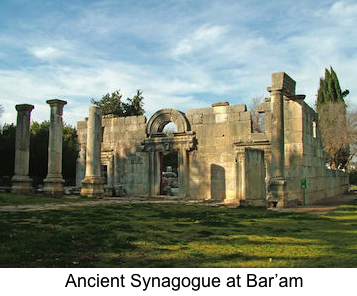
Though the temple was rebuilt during the days of Ezra and Nehemiah, most of the Jews remained in Babylon. They were spread throughout the nations during the time of the Assyrian, Babylonian, Persian, and Greek empires. Josephus estimated the number in the millions. After the destruction of the Temple by the Romans in 70 AD and the destruction of Jerusalem in 135 AD, most Jews were forced out of the land of Israel. Multitudes were taken captive, and multitudes more fled the Roman armies.
Everywhere they went they built synagogues for worship. Synagogues were located throughout Europe, as well as in Syria, Iran, Iraq, India, China, Egypt, Africa, and eventually North and South America.
The synagogue was one of the ways that God kept the Jews from being dissolved into the nations. The synagogues preserved the Jewish Scripture and religion and way of life. Jews had contact with fellow Jews, practiced circumcision, held Jewish weddings, kept the passover and other feasts, and taught the law and the traditions. The synagogues helped keep the Jews separated from their Gentile neighbors.
Each synagogue has a large cabinet where the Torah (the first five books of the Bible) is stored. It is called the ark. This is reminiscent of the Ark of the Covenant which held the Ten Commandments. The synagogue ark is often hidden behind an ornate curtain.
In front of the ark is a lamp that is continually lit and is called the “Eternal Light.” Today it is usually electric. Many synagogues also have one or more seven-lamp menorahs. These point to Christ as the light of the world, and one day the Jews will receive Jesus as the Christ and will cease to dwell in spiritual darkness.
The platform where the Torah is read is raised up above the congregation. It is called the bimah. This is the Greek word for a raised seat that was used in judgment. Pilate sat on a bimah to judge Jesus (Jn. 19:13). Paul was brought before bimahs (Acts 18:12; 25:6). Christ’s judgment seat is called the bimah (Rom. 14:10; 2 Cor. 5:10).
The synagogue is often built so that the worshipers face toward Jerusalem.
Men and women are seated in separate sections. We can see this custom in the outdoor synagogue at the Western Wall in Jerusalem. The women must worship in a separate section that is divided from the men’s section by a fence.
Many synagogues have a chair for the prophet Elijah. It is empty except during the Brit Milah, which is the ceremony of circumcision. At the beginning of the ceremony, the infant is placed on the chair. This is based on a Jewish myth that Elijah watches over every circumcision. During the ritual meal that follows, the Jews pray for God to send the Messiah quickly and to send Elijah to re-establish the throne of David.
Ancient synagogues also had a chair for Moses. One of these was excavated from the synagogue at Chorazin north of the Sea of Galilee. “With their backs toward Jerusalem the elders of the synagogue sat facing the people. The most prominent elder sat in this stone seat upon a raised platform next to the ark containing the OT scrolls. From here, it is supposed, teachers expounded the Mosaic law. This seat symbolized their authority as interpreters of the law in unbroken succession from Moses” (International Standard Bible Encyclopedia). The synagogue at Sardis had a seat of Elijah and a seat of Moses. It appears that these were symbolic of the Law and the Prophets.
The government of the synagogue was congregational. “Priests were always honoured when present, but they had no special synagogue privileges, their functions being regarded as belonging specially to the temple” (J. Sidlow Baxter, Explore the Book).
“There was a ‘ruler’ or president, and a council of elders who were also called ‘rulers (Mr. 5:22; Ac. 13:15). There was a ‘legate,’ whose duty it was to recite the prayers. There were ‘deacons,’ who looked after the alms. There was the chazzan, who called out the names of the appointed readers and stood by the readers to see that the lessons of the day were read accurately, pronounced properly, etc. It was he, also, who took care of the Scripture rolls, blew the trumpet which announced the approach of the Sabbath, saw to the lighting of the lamps, superintended the synagogue furniture, and applied the scourge when punishment was afflicted” (Baxter).
The synagogues were study centers where the rabbis preserved the Scriptures. After Jerusalem was destroyed by the Romans in AD 135, the Masoretic scribes began painstakingly copying the Scriptures in order to preserve them. They counted each letter of the Hebrew Bible, and if a mistake was made they destroyed the manuscript. The most famous Masoretic Hebrew Bible is the Aleppo Codex of AD 900. The Protestant Reformers used the Masoretic Hebrew text as the basis for the Protestant Bibles such as the German Luther and the English King James. At that time it was not possible to know what the Hebrew Bible looked like prior to AD 900, because no manuscripts existed that were older than this. Bible believers trusted God’s promises that He would preserve His Word. But in the 1950s, scrolls of the Hebrew Bible were found in caves near the Dead Sea. They date to 100-200 years BC, a full millennium earlier than the Masoretic Aleppo Codex, yet they were found to be nearly word-for-word the same as the Masoretic Hebrew Bible of the 10th century AD! For example, when Isaiah 53 is compared between the nearly complete Great Isaiah Scroll from the Dead Sea Caves and the Aleppo Codex, there are only three letters that differ. This means that the Hebrew Bible was successfully preserved until the time of printing, in spite of the fact that the Jews were dispersed among the nations and bitterly persecuted.
The synagogues were where rabbis created the myriad of traditions that were added to Scripture. This collection of writings is called the Talmud. It has two parts: The Mishna, which is composed of debates and Jewish legal opinions, and the Gemara, which is a commentary on the Mishna. The Talmud is not based on the Scripture itself, but it is based on the Midrash, which is a Jewish commentary on the Scripture. Thus the Talmud is a commentary on a commentary on a commentary! Even the Midrash commentary is based on an allegorical interpretation of Scripture rather than a literal one and treats parts of the Old Testament as mythical. The Talmud is not organized by Scripture text but by six major subjects: Seeds, Festival, Women, Damages, Holies, and Purities. The rabbis who wrote the Midrash are called Tannaim, and the ones who wrote the Gemara are called Amoraim. Altogether the Talmud consists of 6,200 pages of printed text and contains the opinions of thousands of rabbis on a vast number of subjects. There are two major editions. The Jerusalem Talmud, also called the Palestinian Talmud or the Talmud de-Eretz Yisrael (Talmud of the Land of Israel), was composed in synagogues in Tiberias and Caesarea between AD 200-400. The Babylonian Talmud was compiled in Babylon in about AD 500. The Talmud was exalted to a place of authority equal to Scripture. This process had begun during the days of the Pharisees, as Jesus said: “But in vain they do worship me, teaching for doctrines the commandments of men” (Mat. 15:9). Consider kosher cooking which is cooking according to Talmudic tradition. From the simple law forbidding a kid to be seethed in its mother’s milk (Deut. 14:21), Jewish tradition adds layers of laws. They prohibit cooking a mixture of milk and meat, prohibit eating a cooked mixture of milk and meat, and prohibit deriving any benefit from a cooked mixture of milk and meat. Kosher cooking even requires that separate cooking utensils and dishes and cutlery be used for meat and dairy products so there is no chance of cross contamination. The set of utensils for food containing dairy products is known by the Hebrew word halavi, while the set for meat is basari. Orthodox Jews wait for at least six hours between eating meat and eating dairy products, since food leaves fragments between the teeth and there is therefore the chance of the two being mixed in the mouth!
The synagogues were instrumental in preserving the Hebrew language over the past 2,000 years. After Israel was evicted from her land by the Romans and scattered through the nations, her language was in danger of dying. The preservation of the Hebrew Scriptures in the synagogues by the rabbis preserved the language, and it is the official language today in modern Israel.
The synagogues were a light to the Gentiles that helped prepare the way for the gospel. There is evidence for this in the book of Acts. Wherever Paul went on his missionaries journeys, he began preaching in the synagogues because this is where he found both Jews and Gentiles who had a worldview prepared for the gospel by the light of the Old Testament (e.g., the knowledge of the true God, man’s fall, redemption through sacrifice, and the coming Messiah). Many Gentiles attended the synagogues seeking spiritual light, and many of them were saved when they heard the gospel and understood that Jesus is the promised Christ. “Now when they had passed through Amphipolis and Apollonia, they came to Thessalonica, where was a synagogue of the Jews: And Paul, as his manner was, went in unto them, and three sabbath days reasoned with them out of the scriptures, Opening and alleging, that Christ must needs have suffered, and risen again from the dead; and that this Jesus, whom I preach unto you, is Christ. And some of them believed, and consorted with Paul and Silas; and of the devout Greeks a great multitude, and of the chief women not a few” (Ac. 17:1-4). (See also Acts 13:42-43; 14:1; 17:10-12; 18:4.) The “devout Greeks” were Greeks who had rejected pagan idolatry and joined themselves with the Jews in believing Jewish Scripture and worshipping Jehovah God. The Old Testament was given by God to prepare men for the coming of Christ. It was a schoolmaster (Ga. 3:24). It was intended by God to be a light to all nations (Isa. 45:22; 52:10). The Jews corrupted the message of God’s law by their tradition and created a works religion, and they became self-righteous and racially arrogant, but God still used the Scripture to prepare hearts. We think of the Ethiopian eunuch who traveled to Jerusalem apparently to obtain Jewish Scripture and was trying to understand the prophecy of Isaiah (Ac. 826-28). We think of Cornelius, a “devout” Roman centurion who followed the light of Judaism in Caesarea (Ac. 10:1-2).
Over the past 2,000 years countless synagogues have been destroyed during persecutions against the Jews. For example, during Kristallnacht (crystal night) in 1938, the German Nazis destroyed more than 1,000 synagogues and rounded up 200,000 Jews to send to death camps.
Today the Jews are returning to their land, and many synagogues have closed.
Since the first decade of the 21st century, there have been no functioning synagogues in Calcutta, a city that once hosted a thriving Jewish community and five synagogues. The first Jew, Shalom Aharon Obadiah Cohen, arrived from Allepo, Syria, in 1792. He led in the building of the first synagogue, Neveh Shalome, in 1831. Beth El synagogue followed in 1856; Magen David, 1884; Magen Aboth, 1897; Shaare Rasson, 1933. The Calcutta Jews were led by merchants trading in cotton, jute, spices, and opium. By the mid-20th century there were 6,000 Jews, but they are gone now. They began leaving after the establishment of the state of Israel in 1948. In 2019 there were only 30 Jews left in the city, all 70 or older. A report in the New York Times for Oct. 24, 2013, was entitled “The Last Jews of Calcutta.” Muslims are now caretakers of the defunct synagogues.
In 2021, the last Jew left Afghanistan and the last synagogue closed. Jews had lived in Afghanistan since at least AD 500. At one time the Jewish population was thought to number 50,000. In 1948 the population was 5,000. By 1996, there were only 10 Jews in the one remaining synagogue in Kabul. In 2000, the synagogue’s Torah was stolen by the Taliban. By 2001, there were only two, Zablon Simintov and Ishaq Levin. “They were famous for being arch-rivals, and repeatedly turned each other into the Taliban. This feud was the plot-line for a New York City play entitled ‘The Last Two Jews of Kabul.’ In 2005, the feud ended when Levin died of natural causes, leaving Simintov as the only remaining Jew in all of Afghanistan” (“The Last Operating Synagogue,” atlasobscure.com). Simintov has long been estranged from his wife and two daughters, who live in Israel. Simintov left Afghanistan in September 2001 after the American military departure.
Where are the Jews going? Large numbers of them are going home in preparation for the final fulfillment of Bible prophecy.
- Receive these reports by email
- www.wayoflife.org
______________________
Sharing Policy: Much of our material is available for free, such as the hundreds of articles at the Way of Life web site. Other items we sell to help fund our expensive literature and foreign church planting ministries. Way of Life's content falls into two categories: sharable and non-sharable. Things that we encourage you to share include the audio sermons, O Timothy magazine, FBIS articles, and the free eVideos and free eBooks. You are welcome to make copies of these at your own expense and share them with friends and family. You may also post parts of reports and/or entire reports to websites, blogs, etc as long as you give proper credit (citation). A link to the original report is very much appreciated as the reports are frequently updated and/or expanded. Things we do not want copied and distributed are "Store" items like the Fundamental Baptist Digital Library, print editions of our books, electronic editions of the books that we sell, the videos that we sell, etc. The items have taken years to produce at enormous expense in time and money, and we use the income from sales to help fund the ministry. We trust that your Christian honesty will preserve the integrity of this policy. "For the scripture saith, Thou shalt not muzzle the ox that treadeth out the corn. And, The labourer is worthy of his reward" (1 Timothy 5:18). Questions? support@wayoflife.org
Goal:Distributed by Way of Life Literature Inc., the Fundamental Baptist Information Service is an e-mail posting for Bible-believing Christians. Established in 1974, Way of Life Literature is a fundamental Baptist preaching and publishing ministry based in Bethel Baptist Church, London, Ontario, of which Wilbert Unger is the founding Pastor. Brother Cloud lives in South Asia where he has been a church planting missionary since 1979. Our primary goal with the FBIS is to provide material to assist preachers in the edification and protection of the churches.
Offering: Offerings are welcome if you care to make one. If you have been helped and/or blessed by our material offerings can be mailed or made online with with Visa, Mastercard, Discover, or Paypal. For information see: www.wayoflife.org/about/makeanoffering.html.


